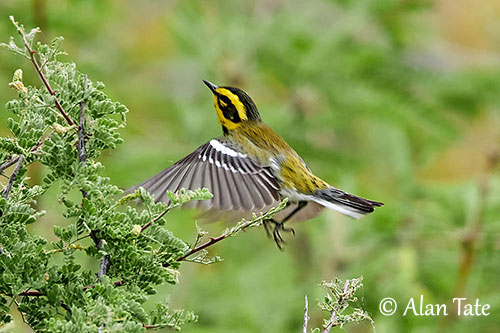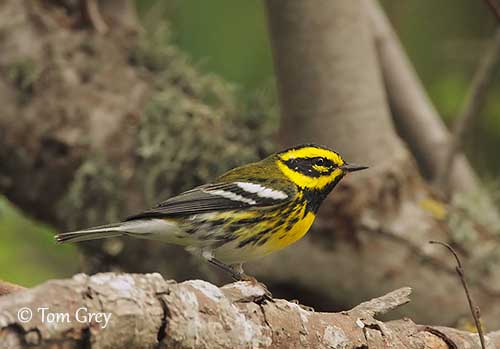
Fr: Paruline de Townsend
Ang: Townsend’s Warbler
All: Townsendwaldsänger
Esp: Reinita de Townsend
Ita: Parula di Townsend
Nd: Townsends Zanger
Sd: townsendskogssångare
Photographers:
Tom Grey
Tom Grey's Bird Pictures & Tom Grey's Bird Pictures 2
Tom Merigan
Tom Merigan’s Photo Galleries
Alan & Ann Tate
AA Bird Photography
Text by Nicole Bouglouan
Sources:
HANDBOOK OF THE BIRDS OF THE WORLD Vol 15 by Josep del Hoyo-Andrew Elliot-David Christie - Lynx Edicions – ISBN: 9788496553682
A GUIDE TO THE BIRDS OF MEXICO AND NORTHERN CENTRAL AMERICA by Steve N. G. Howell, Sophie Webb - Oxford University Press - ISBN: 0198540124
FIELD GUIDE TO THE BIRDS OF NORTH AMERICA - National Geographic Society - ISBN: 0792274512
All About Birds (Cornell Lab of Ornithology)
The Birds of North America online
What Bird-The ultimate Bird Guide (Mitchell Waite)
Bird Web (Seattle Audubon Society)
Wikipedia, the free encyclopaedia
Neotropical Birds – Cornell Lab of Ornithology
Vancouver Avian Research Centre
Townsend’s Warbler
Setophaga townsendi
Passeriformes Order – Parulidae Family
INTRODUCTION:
The Townsend’s Warbler is a colourful warbler that breeds in the coniferous forests of the NW coast of North America. It spends the winter further south on the Pacific coast, with populations in Mexico, Central America and SW USA.
It frequents various types of forests through the year, both for breeding and wintering. It feeds on insects, seeds and spiders during the summer, and also takes nectar and berries on the wintering grounds.
The name of the species pays tribute to the American ornithologist John Kirk Townsend who collected this species and numerous others. The bird was described in 1837.
The Townsend’s Warbler is common throughout the range, and the population is currently stable and not globally threatened.

DESCRIPTION OF THE BIRD:
Biometrics:
Length: 12-13 cm
Wingspan: 19-20 cm
Weight: 9 g
The Townsend’s Warbler adult male has greenish-yellow upperparts with black streaks. On the greyer upperwing, greater and median coverts have broad white tips forming two pale wingbars. The wings are rounded. The uppertail is black with white outer rectrices.
The underparts are yellow with black-streaked flanks and white lower underparts. Throat and upperbreast are black while the lower breast is yellow.
The black feathers have narrow pale fringes in fresh autumn plumage.
On the head, crown and throat are black. The black ear-coverts are broadly surrounded with yellow. We can see a small yellow crescent below the eye.
The pointed bill is blackish. The eyes are dark brown. Legs and feet are brownish to blackish.
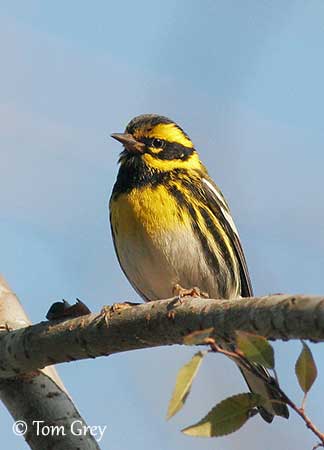
The female resembles male but she is duller. The black parts are mostly greenish to dark olive. Chin and throat are yellow. The tail shows less white on outer rectrices.
The juvenile has mainly olive-brown crown, nape and upperparts. The head pattern and the white wingbars are duller, and the dark ear-coverts are surrounded by pale buff. Throat and breast are dusky and lower underparts are whitish with dark streaks on flanks.
First year male and female are duller than adults overall.
RANGE:
The Townsend’s Warbler breeds in Alaska and NW Canada, S in USA to Oregon, Idaho and Montana. It migrates S to N Mexico and S to Nicaragua, and in smaller numbers S to Panama, and S coastal W USA and NW Baja California
HABITAT:
The Townsend’s Warbler breeds in dense, tall coniferous forest of NW Pacific coast of North America, in the humid coastal regions and in the mountains.
During the migration, it can be found in mountain conifer forest and in lowlands in streamside trees.
It spends the winter in tropical regions where it frequents mountain forests of pine, oak and alder, but it winters mainly in oak and coniferous woodlands along the California coast.
CALLS AND SONGS: SOUNDS BY XENO-CANTO
The Townsend’s Warbler gives dry “chip” or “chik” calls. In flight, it utters a thin, high “see” note.
The song is a series of high “zwee zwee zwee zwee sweezit” notes raising in pitch and then, dropping at the end. A second type of song is a series of short, fast, buzzy notes followed by some more typical rasping notes.
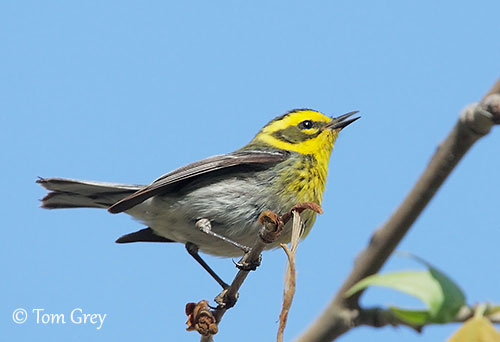
BEHAVIOUR IN THE WILD:
During the breeding season, the Townsend’s Warbler feeds mainly on insects such as caterpillars, true bugs, beetles, leafhoppers and numerous other species. It may take some spiders, seeds and plant galls too. During winter, it consumes insects, berries and nectar.
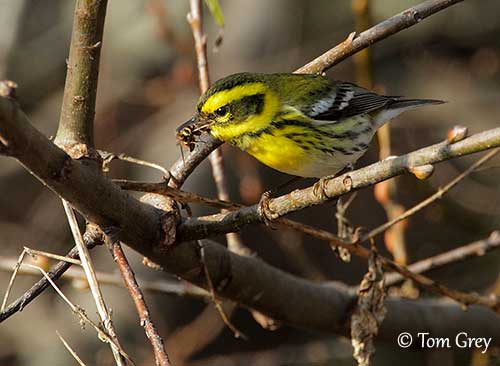
It usually forages high in trees, searching for prey among twigs and hovering to take items from the foliage. It may sometimes fly out to catch insects in the air.
Outside breeding season, it often forages lower down and even on the ground. It may join mixed-species foraging groups.
At the beginning of the breeding season, the male sings from high in trees in order to establish the territory. They are monogamous. The pair forms shortly after the female arrives.
The Townsend’s Warbler is migratory and most of them move through the W mountains and along the coast to reach their wintering grounds. They leave the breeding grounds from early August through September, and arrive in their wintering areas from late September. They return from April and reach the breeding grounds in early May.
Vagrants are reported in E North America in spring and autumn, in Bermuda in autumn and in Colombia in winter.
The flight is weak with rapid wingbeats.
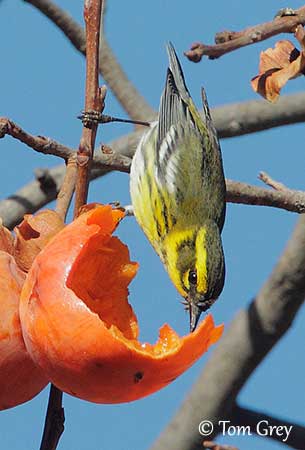
REPRODUCTION OF THIS SPECIES:
The breeding season occurs between May and July. The Townsend’s Warbler builds a bulky cup on top of branch, often towards the end of horizontal conifer branch, very high in tree.
The cup is made with pieces of bark, twigs, grasses and lichens. It is lined with softer materials, usually hair and feathers.
The female lays 4-5 white eggs with brown markings. The incubation lasts 11-12 days, probably by both parents but perhaps by female alone. The chicks are fed mainly by the female and possibly by the male too. The young fledge 8-11 days after hatching.
